RV: (00:00) Hey brand builder, Rory Vaden here. Thank you so much for tuning in to listen to this interview. We are so excited to bring you this information and wanted to let you know that Hey, there’s no sales pitch coming from anything that we do with. This is all our value add to you and the community. However, if you are somebody who is looking for specific strategies on how to build and monetize your personal brand, we would love to talk to you and we offer a free call to everyone that’s interested in getting to know us and is willing to give us a chance to get to know them and share a little bit about what we do. So if you’re interested in taking us up on a free strategy call, you can do that at brand builders, group.com/summit call brand builders, group.com/summit call. Hope to talk to you soon on with the show. RV: (01:03) Oh my gosh, I love D’Arcy Benincosa. You’re gonna love this woman. She is so fun and so cool and so intelligent and a true professional. So she is, has been, I think one of the most sought after destination luxury wedding photographers in the world. But out of that, she’s also become a very well renowned business coach, specifically for creatives. And that’s part of why we brought her on here today. So she and I met through a mastermind that she was involved with and then she became a client of brand builders group and I’m always kind of like, why are you a client? You’re so amazing. But she’s so humble and she’s such a student that way. And then she was in one of our events and everyone started asking her all these questions and it was like, Oh my gosh, we have to just get D’Arcy in front of all of you so that you can learn because she’s done a ton. RV: (02:00) Okay. So she’s as a photographer, I mean, she’s been featured in so many different things and as, and as kind of a a business coach or teacher she’s been featured in HuffPo, ABC, NBC, the view, Upworthy, I mean, her photography has been in every major wedding publication like Martha Stewart. And Harper’s Bazaar and style me pretty like so she’s got a master’s degree, so she has that interesting balance of like classic education. Like me, I have a master’s degree but also really am more of an entrepreneur. And anyways, I’m just excited for you to, to meet the energy that is D’Arcy, Benincosa. So welcome to the show. Oh my gosh. It’s such a privilege to be here. Thank you so much for having me. Thank you for that introduction. I’ve done a lot in 40 years. Well you don’t look forward to at all. RV: (02:57) And so I guess there’s so many things I want to ask you about, but I, I think that the place that we should start just to like get right to what is probably most relevant for our audiences is I think that of all of our clients, you’re one of the people that is really well experienced with video courses, creating them, pricing them, launching them, promoting them. And so like, I think maybe we just dive in with that. So, so how many courses, like is it w give me an idea of what percentage of your business come from courses and how many courses do you have? And like just give us like the overview of what courses mean in D’Arcy’s world. DB: (03:41) Yeah. So for a long time I was just shooting weddings. I think a lot of us just offer a service, right? I was out shooting weddings, doing brand shoots. I was so good at storytelling. And of course is always happens when you get really good at some thing. People who want to be good at it start inquiring, Hey, can you teach me how to do that? Can you teach me how to do that? And I realized as a business person, yes I was tied to photography, but I knew I didn’t want to be shooting weddings when I was 70 so I thought this is a great new Avenue of another client I can serve. So I started creating the education and creating ways of helping photographers, book clients. So at first it was about 0%. Then I would say the year I finally decided to launch a course, it became a third. DB: (04:37) I launched a course audience. If I had a six figure launch my first time launching something because I really didn’t launch until I had served my audience for a couple of years. And that launch was huge for me. I didn’t do any paid advertising either. That was my mind. So all my clients were just ready to buy what I had to offer because I had been serving them. And I think making sure you don’t launch too soon before you’ve served them enough before they want, you know, there’s so many laws to marketing. Talked about the law of reciprocity is a big one. Make sure you’ve given so much to them, but that by the time you launch something, they are just ready to buy from you because you’ve served them so well. And I think that’s what happened with my first course. And then I got really zealous and right after that I created another one. And I think I did that a little too soon. But then I started listening to what they were asking and I, I started creating things that I did really well that I didn’t realize people would pay me to learn. Like I thought, Oh this isn’t a big deal. And then it turned out to be something everybody needed help with. So I have a lot of courses, I’ll be honest, I have probably more than a lot of people recommend, but they do really well. RV: (06:04) Interesting. Okay. So so that when people hear course like how many videos, I know this is such a basic question, but like how many videos are in a course, how long do they have to be? How professional? Like how professionally shot do they have to be like, you know, do you have to rent a studio and go do it with like full lighting? Can you do it on your phone? Like just give us a sense of of that. And maybe maybe correlated with price points. Cause I’m sure it’s like the answer is, it depends. It can be all those different things. But just since you’ve actually had so much different experience, like how would you kind of price, you know, different modalities and volumes and that kind of thing. DB: (06:50) So let me tell you my lowest price course than my highest price course. So my lowest price is $49. It includes 15 videos that are each about six to 12 minutes long. RV: (07:03) Say that again. How many DB: (07:04) 15 videos that are each six to 12 minutes long. Okay. And it’s a very niche course. It’s teaching photographers how to shoot a meter film. Do you remember film? RV: (07:19) I do remember film, but I don’t know what meaner film is. Is that like filming? DB: (07:24) Yeah, most people shoot digital, but film is making a comeback, especially with hipsters. I’ve always, I’ve always shot it. So I’m teaching people how to meet her light for their camera to shoot film. Okay. I do it really quickly, really succinctly. And it’s a $49 course. I put it cheaper because it’s really easy. It’s quick to get through and I wanted them to have an experience with me so they could see how I was as a teacher. And that one, I just have one video from the course on YouTube. It’s the most searched YouTube term by photographers. You guys might not get it so don’t get lost in the language but it just says how to shoot a meter film and that’s exactly what they type into the search bar and I don’t know RV: (08:14) The title of your video. Okay. DB: (08:16) That’s the title of one of the videos in the in the course that I put on YouTube and then I have a link to buy the $50 course and that, and I sell a couple of those a week. They’ve paid for my groceries. That course has paid for my groceries since I put it up in 2017 and the awesome thing about that content is it never changes. Shooting film is a thing that is always the same. How to do it is always the same, which is awesome to have as a course. RV: (08:46) So your whole funnel, there is one of the videos in the course you made publicly available and then you have a link in the description and like a card that comes that slides out. DB: (09:00) If you want to learn more in depth, this is what I cover. Click here to buy the course because there are a lot of other videos on YouTube like that, but mine is the best. I’m a really good teacher and I did my research well and I made sure I was very clear. And and so it’s a, it’s a 12 minute video. It has almost a hundred thousand views and people are watching it every single day and it, it goes. Yeah. And that’s one of the, RV: (09:29) One of the funnels. And so it’s not even like, it’s not even really a marketing, it’s the actual video in the course itself. And then if you want more boom and you click and you go to a sales page that tells what’s in the course or do you go straight to your shopping cart? DB: (09:42) Yeah, pretty much too. I think a landing page, it could Jobie that then tells what’s in the course and they can just buy it. RV: (09:49) Got it. And did you shoot it on your iPhone or, I mean you’re a photographer so you have a little bit of an advantage with the production quality. DB: (09:59) So I used to make a ton of YouTube videos and I would rent out a studio for like 300 bucks and pay my friend 300 bucks and he would come in and we would shoot all day long, 12 hours a day. We were in a studio that had light and then he would go and edit all of the, all the videos. So I created that course in about two hours. I just wrote down everything people need to learn. I got up, I taught it. I didn’t need a lot of cue cards for that one. I had my meter, I had my camera and that one was really easy and I could run paid ads to that if I wanted. I just have other things that I run ads to. So that one I had just, I love seeing how it performs on YouTube. RV: (10:43) Interesting. Interesting. Okay. So what’s your most expensive one? So my most DB: (10:47) Expensive one is a, the one without me. So I do coaching with me, but without me, it’s 1495. It’s 1,495 it’s called the marketing map. And it’s basically how to market yourself as a creative with really tried and true services. If you are just a service because so many of these things that teach you are like, you have to have a product or a course or anything like this. And this is basically like I have a service if I was a photographer, you know, so these are photographers, different kinds of creatives that have one service to offer. How do you market them? And it goes through very in depth how to market that. And that I launched I did RV: (11:30) So hold on. So one thing just for y’all listening, cause this is interesting because in our phase one event, we talk about five ways to monetize a personal brand and we call them the paids PA IDs. But then you know, the S is services and we talk about how the fastest path to cash is a service is your time for money, but it’s the least scalable. And I think that’s really, really unique because you’re right, everyone teaches you how to sell one of the other ones, but to actually get more gigs if you’re a senior or get more bookings if you’re a photographer. So that’s really specific. So how many, so what’s, what, how many videos are in it and how long is it and all that. DB: (12:10) Yeah, and I will say really quickly, most people come to me with only knowing how to sell their services. And what I teach in the marketing map is, yes, here’s how to sell your service. But then I also give them a lot of ideas for how to eventually bring in passive income. Because the way I serve my clients is let’s monetize your service. Let’s get you making six figures at least because everybody’s working way too hard to not least be making six figures. And then let’s open up your mind and let that creative genius flow for how you can eventually change your business model to not be so service-based so you can not work so hard and you know, but a lot of people at the beginning of their businesses service-based. I think that’s where we all kind of start. And then we learn what our gifts are. So that one is six maps. So it’s six, I call them maps instead of modules cause I’m a destination wedding photographer, travel all of that stuff through it’s six maps. And in each map there are four videos. And then I update that with very good masterclasses about every quarter. So I have genius SEO people come in genius, you know, Google analytics, people come in, blogging people things like that where I’m always serving that audience by, by recording new masterclasses as well. RV: (13:33) Oh, okay. So that’s kind of you, you include them in like a growing archive of just specialty classes. How many, so, but, but then the set part of it is for, you said it’s six modules or videos. So it’s 24 videos. How long are they? DB: (13:52) You know, I know most people say only do like 10 minute videos. I think you need to know how compelling you are. And I happened to be a really good storyteller so some of my videos are up to 25 minutes long, maybe 30 I didn’t plan them that way, I just had so much to share on that. But I try not to overwhelm. So they’re very well organized. They’re very much by topic and they very much lead on a journey. Now I could have included another 40 videos of content, but you want to make sure you don’t overwhelm your audience. And one thing you really want to make sure with courses is that people can finish it because they feel successful when they finish it. And I have a very big mission to help people finish their courses with me because how many of us buy a million courses and don’t finish them? I have been guilty of that. And so I like to make my clients feel very successful. So very much like I led them on a very targeted journey that all over the place. RV: (14:53) Well. Well I think the thing that’s interesting to me as you go that one is 24 videos, right? Your other one, the $49 one is 15 videos. So it’s not really about, it’s not really about the quantity of videos, it’s more is it’s priced more upon the value of the information to the person about what, how, how translatable this information is into helping someone make money from what you’re teaching them. DB: (15:20) Yeah, I think so. Cause with the, how does she meet her film? I’m TA, I’m teaching them one basic skill. That skill could or could not bring them in, come into their business. It’s more like this could be a hobby, this could be something. I just want to learn for fun. The marketing map, if they follow what’s in there that teaches them how to have a half a million dollar photography business, which is, and, and they could scale it to even more. But that’s basically where I’m coming at it from because you can’t make more than half a million if you, if you only offer services. That’s my opinion in photography because you’d be shooting all the time and you wouldn’t have enough time to edit and all of these things. So it’s basically how to scale to that with the idea of, Hey, if you want to, then after the services bring in passive income and stuff, it hints at that, but it doesn’t niche to that. RV: (16:13) Okay. So then the, so the four, so for this one, let’s talk about the marketing map or just the one that’s 1497. So how do you market it? And you said you had a six figure launch, your first launch, like, so part of this, I guess as you go, okay, what, what skill set do I have that I can teach people your outline, the course. I mean, this is what we do in captivating content, right? In our event, we’re kind of like, okay, let’s outline it. Let’s block it all out. Then you come into a studio, you’re going to shoot, you’re going to shoot it, you’re going to have to edit the videos and eventually you’re gonna have to upload them somewhere, whether it’s Kajabi or Thinkific or it could be YouTube, unlisted if even if it was like your first, your very first course. But like once you have the course done, how do you sell the actual course? Like what are all the things that you, well, let’s talk about what you did in that first one and then what you do now because you didn’t do any paid acquisition before. DB: (17:10) And I will say in the marketing map, you only see me during the welcome video. The rest of the time it’s PowerPoint presentations with my voice because I created it all at home and my neighbor’s dog barks a lot. So I had to create these videos at like 1:00 AM so I was in my room, which hoarding with my voice, I would mess up. So if with ScreenFlow you can record your whole screen, I would have a PowerPoint. If I didn’t like how something sounded, I’d stop, rerecord it. And then you can edit everything out, you can edit out your ums, your mistakes, you know, you get really close to a microphone. Suddenly every breath you intake sounds so loud so you can edit all of that stuff out. So the way that I did it is I did webinar, a webinar funnel first, and I had read everything, Jeff Walker’s launch book, everything that said like do a 10 day, 14 day launch. And I just knew that wasn’t enough time for my audience. So I actually launched for six weeks and every week I would teach a live webinar because I’m really good live and I wanted to serve them out, answer all their questions. And so I would Mark it the live webinar on Instagram, which is where most of my following is. And to my email list. And every week I got on and did a live webinar and I closed some of those webinars at $40,000 at the end of it with people buying the product. RV: (18:40) And so that was it. That was, you’re saying that’s the same webinar repeated six times or six different? Yeah. DB: (18:47) Okay. Nope. Same webinar and I just got people on there live. And here’s the crazy thing, you guys, I didn’t have the course created at the time I started selling it because I think all of us have a course or something inside of us, but it is always takes the back the back, you know, we just always put it off in terms of other work and I knew if I had sold it, I would make it. So I not only sold the course for six weeks, it, I took six weeks to make it. RV: (19:20) Oh, so you were making it during that time that you were selling it? Yeah. DB: (19:22) Yeah. And I got their questions like I had it outlined, I knew what I was doing, but with more of their questions, I was like, Oh, I should add that in. Oh, that needs to be added in. And then I would just create videos and content every night. Like it was crazy. It was crazy. RV: (19:36) And your webinar. Okay, so your, so your webinar, so this is like classics and this is classic phase two brand builder stuff too, right? It’s like we’re all about the webinar funnel. You’ve got some traffic sources, you drive them to a webinar, you rock their world, like give, give, give, and then you tell them what you have available. Like it’s not rocket science. If you know something and you serve people and you create reciprocity, like you’re going to sell some of these. If you, if, if you’re, if you’re teaching on something that you should be teaching on, like something that you know something about, but the webinar itself, did you create like fancy slides for it and all of that stuff? Did you, so you take the time to create like a nice webinar slide deck. DB: (20:23) Yeah. Here’s the thing about photographers and knowing your audience is so helpful. Photographers are very much about aesthetic, so I don’t do like these masculine click funnel type things. Mine are very beautiful. They’re very much photography heavy. They all have a strong brand. From the way I present my fonts, like I feel like the visual identity of my brand is of the top that I have seen and it’s very consistent. So my slides are gorgeous and they show compelling images. I talk about, you know, how I took these images, you know, working with Harper’s Bazaar and Thailand and all of these things that people, you know, not to brag but to show this is what you can do when you build your business in this way. So yes, I had beautiful slides and I really taught something in the webinar that wasn’t in the course but very much served them and made them want more. And it really gave them the experience of, Oh my gosh, if I just got this much information off of D’Arcy off 60 minutes, what could I get from an entire course? And that’s the way I’ve always wanted my run my webinars is I want people to feel like what they got off my webinar. They would have literally paid at least $300 of information for RV: (21:45) Yeah, that we feel the same way. Like it’s, our philosophy has never been teased them, don’t give them anything and make them buy. It’s the inverse. It’s, it’s like over-deliver. And in fact, we, you know, for us, you know, grant Cardone has his 10 X rule for us, the 10 X rule that I think about is deliver 10 times the amount of value in advance of what you’re asking them to pay. And then, you know, it’s like exactly what you’re saying when they’re gone, man, I’ve gotten so much already. Like how could I, how could I not buy from this person? So, so I love that. But that, that was it. It wasn’t, there weren’t Facebook ads. Like in your case, you had an organic audience between Instagram and email that you had built up and you just said, Hey, come check this out. So you, the, the, the only thing you really designed was like that first slide deck. And then you had the outline of the course clearly. But, and then you were designing the course on the fly as you went along. DB: (22:43) And I think, I use my sense of humor in Instagram stories. So I called it magic marketing and I photo-shopped myself in the pitcher of magic mic, which, right. We did not know this movie, but I know that with a lot of my, I was, I was almost cast for it as I could see that they weren’t willing to pay me enough money for my abs. So I was like, so I think I use my hands humor, I use my, my compelling newness. You know, I, I went online and invited people there, made sure that they won’t want to miss it. And that’s the one thing about my audience. You know, everybody can create a course, but I think once you sell a course and people do not give good feedback and you kind of missed your boat or you didn’t know over-deliver or you sold the course, you had no business teaching and you didn’t have enough experience. DB: (23:34) There are a lot of people in the industry and when people buy from you, they’re like, Oh I’ve been burned before. You know, and I, I really think having a high standard, if you’re going to become, like you said, your reputation. So I make sure every course, I don’t make sure it’s perfect cause then I never put it out. But I make sure that like it is what I know. I can teach that I’m very good at it. I’m organized. Organizing the information is huge for people as you teach. And I’ve learned from you making sure you have organized information that is easily obtained, you know, and ingested by people so they can take it away and change a behavior that I learned that changed behavior from you at your captivating content. I have been doing it. I just didn’t realize I was changing a behavior. And that’s really key for courses. You want people to come away transformed. RV: (24:30) Yeah, I love that. I mean it’s, it’s kind of like the best marketing ever is when your students actually change their, their actual behavior because then they’re thinking about you and they’re doing things in there telling people. So I really, really love that. So, so, so that was how you launched the first one. Now what happens after that? Like how do you, how often have you launched, do you, you know, do you do paid traffic now? And I mean, yeah, I mean 1500 bucks. Like you don’t have to sell too many of those things, you know, most people to in order to quit their job kind of a thing. You, you could, if you’re good at building an audience and doing it consistently, like so, so what happens after that first launch? DB: (25:15) Yeah, so I think what’s really important after that first launch is to understand your content calendar. So at the beginning of each year, I map out my exact sell dates, like what am I selling so that I can preplan the content that I’m putting out that goes along with it. So for example, my next big course that I’m launching, it’s a new course. I’m launching it in may. That means everything from March and April is content that helps people see, Oh my gosh, I will eventually need this course. So I think planning out your content, selling three to four times a year, not being afraid to sell. I was on a coaching call with actually some people that we know about courses and somebody said I don’t want to be annoying when I sell. And you know, women are the only ones who asked me that question. DB: (26:10) No man is ever like, I don’t want to be annoying when I sell. And I think, you know, if you’re really offering a service then selling is part of that. So I make sure I sell about four times a year and a mistake that I made was trying to sell too many things at once. I remember I had a course, I was launching a group coaching program I was launching and an in person retreat and I needed to sell them all at the same time. That was a horrible thing. It was really hard to sell any of them. Well, and I did that last year. I was like, Oh my gosh, we plan too many launches at once. So this year we’re very careful. I have exactly the dates where I’m selling things. So from that you can keep selling one signature course if you want. DB: (26:58) Like Marie Forleo’s model, she sells B school every March. She then does live calls with it for six weeks and the rest of the year she’s putting out free content that drives people to trust her to then join B school. I love teaching, so I have a lot of courses. I put out one that was cheaper. It was one 49 and it answered a very niche question. It was how to prepare proposals. I do custom proposals for all my luxury clients, how to prepare those to make sure that you book that client, how to give them like you call a compelling offer to make sure you book that client and how to make sure that proposal speaks to them. And that course has been really, really powerful. And so yeah. RV: (27:52) Okay. Are most of your courses towards that lower or are most of your courses like South of a couple of hundred bucks or is it just kind of like all over the place? DB: (28:00) Yeah, I have. So with my product value ladder, which is how do your courses rank? I have one 49 I have two one 40 nines and then I have the 1400 so now I’m creating the four 97 and I think a four 97 course is a really sweet spot because people, we’ll be willing to spend that much. It’s not a thousand, right? So many people talk them selves out of selling a thousand. But it is enough that you can make a really good launch out of it. And those are, that’s the one I’m putting a lot of paid ads. I haven’t put paid ads behind the 49 and I haven’t put paid ads behind the one 49 when we relaunched the marketing map, I had hands-off did nothing. One funnel with Facebook ads and launched it again, RV: (28:50) The 40 this is the 1497 one you’re talking about. So and then give us a sense of that. Right. So, so yeah, and one reason, you know, like we would tell people it’s, it’s kinda hard to run like an evergreen paid ad campaign on a course that’s South of maybe 200 bucks because the cost per acquisition, the price is so low. You know, it’s hard to break even now when you look at the lifetime value of that customer, if you’ve got that kind of sophisticated tracking on the back end, it could still make sense cause you’ll escalate them over time. But just on that one funnel alone, which is really what we want to do with paid paid acquisition is if we can at least make money on that very first buy, then everything from that point in the future is gravy. And and you know, it’s like you can spend as much you as fast as you can to acquire new email addresses and stuff. So, but the 1497 one, that one is super valuable. You’ve proven that you’ve got a webinar that will sell that. So give us an idea of like, what do you expect from like a closing percentage? Like, how many people register form one of these webinars? How many show up, how many actually buy, how long does it take? And then, you know, like at the end of the day, what percentage of people might actually buy something at that price point? DB: (30:15) Yeah. So the rule of thumb is that you will sell from eight to 12% of the people who are on the webinar. I, I remember, I think it was Russell Brunson said if you sell over 12%, email me right away cause I need to know what you’re doing. And he sells a lot of things. So I have a really high close rate. So I have had a few webinars. I know why when I do live I sell better. That’s why I like to do six, five or six lives because then I choose the one where I really nailed it. And that’s the one I put for the replay. So when we relaunched the marketing map a year later, well actually we did it six months later. I think we needed to do a year because my audience hadn’t grown enough. But we relaunched it for 10 days and it made 60 K in 10 days and I only put a thousand dollars behind the ads. DB: (31:07) So that’s not too bad. That was like, you know, a nice 10 day thing and I did nothing for that one. But I closed it about 12% I would say I’ve had one webinar and I CA, I think it was just a really engaged audience where I closed at 15 and then I had one webinar where I closed I think it eight and that felt like the biggest failure. It’s really hard to feel like you know how to pick yourself back up after a webinar because you do put so much into it. So you have to give yourself RV: (31:41) Now was this eight out of a hundred people or is this 80 out of a thousand people? DB: (31:46) Yeah, I usually have about 500 people on the webinars. RV: (31:49) So that means like a thousand of registering. DB: (31:52) Yeah. Yeah. I thought I was going to 1400 and then they’ll, and then they’ll rewatch about about 20% rewatch, maybe 15. Not rewatch, but watch it. They don’t come on live, you know, they, I don’t sell as well on the replays. Because you know, you want to give those bonuses live. So when they’re watching it live or the first time they see it, give them access to bonuses. And I’ve heard that the bonuses are almost as important as the course. So making sure you have bonuses that truly are what your absolute ideal client wants and cannot say no to. RV: (32:38) Yeah, for sure. And I think yeah, so just so you have like 1400 register, 500 show up, and then so 10% would be 50 people. So you might sign up somewhere around 50 people out of that live. Then you’ll have another 20%, so maybe another 200 people watched the replay and then you’ll get like some smaller, DB: (33:01) Like 10% of them as well. Yeah, eight to 10. Yeah. RV: (33:06) And then did that, and these aren’t evergreen, so these aren’t always running. You’ve always done like a couple of launches a year and you’ve done like a launch model. DB: (33:16) Yeah, the profitable portfolio, which I’m creating now, that one will be my first evergreen because it’s the perfect formula for evergreen. It doesn’t need a big emotional hit to buy. It’s a very tech technique based course. And I think sometimes we have these technique based courses that sell really easily. Like I’m teaching editing, I’m teaching this. Whereas some people try and sell mindset or grand ideas or these bigger kind of things and that I think you really do need that one to one connection with your client. So the profitable portfolio, you could know me or not know my reputation and still understand the value that’s being led here. Just from seeing my work and my accolades. You know, my list of publications already show this woman is qualified to teach this. When you get up into 1500, 2000 my group coaching is 4,500 a person. They really need to have that experience with you. And most of my coaching clients have been following me for a while and really know and trust me. RV: (34:24) Yeah. and then Facebook ads and stuff. So are you doing a lot of that now or is that more like you’re learning, you’re learning that space in terms of driving? DB: (34:33) Yeah, I’m really good at Facebook ads. I know when to launch them. I haven’t run them full time, but we did recently starting in January start a lead magnet that’s really great. It’s for teaching people how to have an Epic website, 10 things to have 10 things not to get rid of immediately. And that’s my website. I relaunch it every single year. It’s a launch that, you know, having launches in your business that people look forward to I think is something that can really build your brand and get people who may not have bought from you previously to buy from you because they get really drawn into the story of your business and how it serves them. So we do that as a lead magnet that we’ve started since January. And and then with the profitable portfolio, I have a budget usually around three to five grand a month for where my business is and how I want to scale it that I’ll be doing ads for. And this one, I’m going to do the launch and everything straight off the bat with ads. RV: (35:35) And that’ll be so like for six weeks, just like three to five grand over the course of six weeks maybe. I would say three to five grand a month. Yeah. So if I go into six weeks, I was planning on doing it for a month and then I’m taking it into the, into the evergreen funnel and see how that does. Gotcha. yeah. Well I know I’m excited. Cause you haven’t been through our phase three event yet. I don’t think I need to sign up for that one. That’s the one. That’s the one where we get into all of Facebook ads and Google and.

















